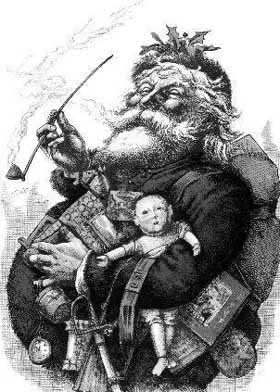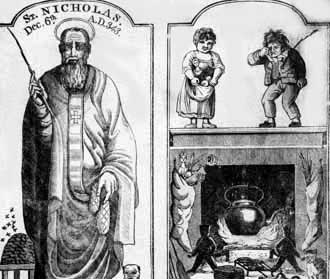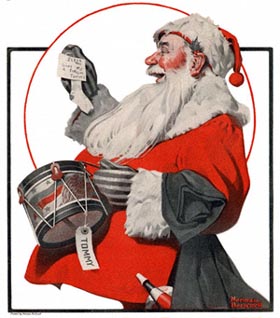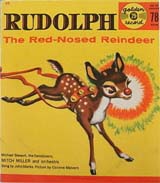pop up description layer
HOME
Cryptozoology UFO Mysteries Aviation Space & Time Dinosaurs Geology Archaeology Exploration 7 Wonders Surprising Science Troubled History Library Laboratory Attic Theater Store Index/Site Map Cyclorama
Search the Site: |
|
AKA Santa Claus
Every December 24th millions of people are visited by a short, fat guy in a red suit. Where did he come from, why does he do it, and how does he accomplish this seemingly impossible task? Santa Claus... Kris Kringle...Old Saint Nick... We see him on advertising posters, in parades, at departments stores...who is this guy and why does he have so many aliases? Well, the original St. Nicholas lived in southwestern Turkey in the 4th century. As the bishop of Myra he was credited with doing a number of miracles involving sailors and children. After his death this led him to become the patron saint of both groups as well as for unmarried girls. As a saint he was given his own "feast day" that was celebrated on December 6th. At about the same time Nicholas lived, Pope Julius I decided to establish a date for the celebration of the birth of Jesus. As the actual time of year for this event was unknown, the Pope decided to assign the holiday to December 25th. There had long been a pagan midwinter festival at this time of year and the Pope hoped to use the holiday to christianize the celebrations. Eventually, Saint Nicholas's feast day also became associated with December 25th and his connection with Christmas was established. A tradition developed that he would supposedly visit homes on Christmas Eve and children would place nuts, apples, sweets and other items around the house to welcome him. As the reformation took a hold of much of Europe, however, the popularity of St. Nicholas dropped in most Protestant countries, with the exception of Holland where he was referred to as "Sinter Klaas." After this tradition came to the United States, "Sinter Klass" would eventually be corrupted to "Sancte Claus." America's Santa
It's been said that Dutch settlers brought the tradition of Saint Nicholas to the North American city of New Amsterdam (which the British would later rename "New York"). However, research shows there's little evidence that Nicholas played much of a part in these early settlers' celebrations. It seems more likely that Saint Nicholas became an American tradition during a wave of interest in Dutch customs following the Revolutionary War. Washington Irving (of Sleepy Hollow fame) included him a comic History of New York City written in 1809. John Pintard, founder of the New York Historical Society, took an especially keen interest in the legend and the Society hosted its first St. Nicholas anniversary dinner in 1810. Artist Alexander Anderson was commissioned to draw an image of the Saint for the dinner. He was still shown as a religious figure, but now he was also clearly depositing gifts in children's stockings which were hung by the fireplace to dry. Perhaps nothing has fixed the image of Santa Claus so firmly in the American mind as a poem entitled A Visit from St. Nicholas written by Clement Moore in 1822. Moore, a professor of biblical languages at New York's Episcopal Theological Seminary, drew upon Pintard's thinking about the early New Amsterdam traditions and added some elements from German and Norse legends. These stories held that a happy little elf-like man presided over midwinter pagan festivals. In the poem, Moore depicts the Saint as a tiny man with a sleigh drawn by eight miniature reindeer. They fly him from house to house and at each residence he comes down the chimney to fill stockings hung by the fireplace with gifts. Moore had written the poem for the enjoyment of his own family, but in 1823 it was published anonymously in the Troy Sentinel. It became very popular and has been reprinted countless times under the more familiar title, The Night Before Christmas. Where did Moore get the reindeer? The Saami people of northern Scandinavia and Finland often used reindeer to pull their sledges around and this found its way into the poem. Reindeer, which are much sturdier animals than North American deer,are well adapted to cold climates with their heavy fur coats and broad, flat hooves for walking on snow.
As time went by, more and more was added to the Santa Claus legend. Thomas Nast, a 19th century cartoonist, did a series of drawings for Harper's Weekly. Nash's vision of Santa had him living at the North Pole. Nash also gave him a workshop for building toys and a large book filled with the names of children who had been naughty or nice. The 19th century Santa was often shown wearing outfits of different colors: purple, green and blue in addition to red. This slowly faded out so that by the beginning of the 20th century the standard image of Santa Claus was a man in a red suit trimmed with white. The Coca-Cola company has often been cited for cementing the image of Santa with the colors red and white through a series of popular advertisements in the 1940's depicting Saint Nick enjoying their product (Coca-Cola's company colors are red and white). However, Santa was already well associated with these colors by that time. American artist Norman Rockwell had done a number of paintings with Saint Nick wearing red and white including A Drum for Tommy which appeared on the cover of The Country Gentleman in 1921. The truth is that by the time the Coke ads came out, Santa, in the public's mind, was already wearing only the modern version of his colors. Santa Physics Santa has been very popular in the 20th and 21st centuries but in the past few years he has had a few detractors. In January of 1990, an article appeared in Spy magazine under the name of Richard Waller that was skeptical of Santa's capability to do what he supposedly does each Christmas Eve. The article, after its initial appearance in the magazine, was republished innumerable times on the web and emailed all over the Internet. Among other things Waller calculated that Santa, moving from east to west around the globe, could use the different time zones and the rotation of the Earth to extend his night for as long as 31 hours. Since he needs to visit approximately 92 million households (the number of Christian children divided by the average number of children per household) according to Waller this means he needs to travel approximately 75.5 million miles. The article states that the distance divided by the time means Santa's sleigh must move at a speed of 650 miles per second, 3000 times faster than the speed of sound, to complete its route.
Waller then went on to calculate that if every child gets a two-pound present, Santa's sleigh must weigh about 321,300 tons. He then ups that figure to 353,430 tons to account for some 214,200 reindeer he thinks would be needed to pull that heavy a sleigh. This total weight is about four times that of the Queen Elizabeth. The article ends by noting that if the sleigh and team attempt to move through the atmosphere at 650 miles per second they would be exposed to enormous air resistance (the same way a spacecraft gets heated upon reentering the atmosphere) and they would explode in flames. Waller sarcastically ends the article noting that if there ever was a Santa, given the acceleration forces such a flight would subject him to, he must now be dead. High-Tech Saint Nick Numerous rebuttals have been written to the Spy magazine article. Some point out that there are flaws in Waller's calculations or assumptions. For instance, the payload problem could be handled by making numerous returned trips to the pole. It increases the length of the total trip by a tiny fraction, but divides the weight of the sleigh by the number of return trips. Other writers note that Christmas does not come on the same day in all countries. Orthodox churches celebrate Christmas a few days after December 25th which means Santa gets at least two shots a year to complete his mission. One writer noted that the number of stops needed in the calculation is incorrect since dividing the total number of children by the average number of children per household to get the number of stops does not consider families where there are no children at all. Roger Highfield, who wrote the book Can Reindeer Fly? The Science of Christmas, suggests that Wallers has not considered that Santa might have some high tech solutions to his problems. For example, "inertial dampers" - a device that's referred to in the Star Trek movies to keep the crew from getting shmoshed as the Enterprise accelerates to Warp 8 - could be used by Santa to solve his high-acceleration problems. The technology isn't known to our science, but to Santa, well, who knows? In fact some people have even suggested that Santa has the technology to manipulate time. By creating an artificial time bubble around his sleigh and his person, he could speed himself up as much as he needed. Again, this is far beyond human technology, but... However Santa does it, he seems to manage each year to delight millions of children on Christmas morning as he has done for over a century. Perhaps it's just magic. Copyright 2003 Lee Krystek. All Rights Reserved. |
|
Related Links |
|
|







